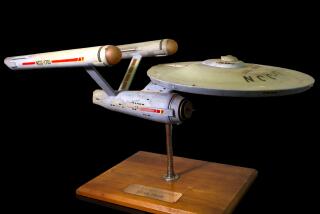Providing a memorial to materiel
Memorial Day traditionally honors military veterans who died in America’s many wars, but amid all the ritualistic remembering, some “veterans” are mostly forgotten, namely, the cannons and war wagons that accompanied flesh-and-blood vets in training and battle.
Beneath tall, swaying evergreens and palm trees, more than a hundred such antiquities rest in splendid obsolescence in a dusty dirt lot in South El Monte. Retrograde tanks and personnel carriers, outdated anti-aircraft guns, boxy Jeeps and hulking trucks of World War II, Korean conflict and Vietnam War vintage, all crowd the premises at the easily overlooked American Society of Military History Museum.
Every artifact in the place is armored, if only with resonant memory for the once-young men who operated them in all their former power and ferocity.
The museum, brainchild and life’s mission of Don Michelson, was established as a nonprofit in 1962. Michelson was an officer in the Army’s Quartermaster Corps during World War II, and later was the longtime boss of the PX at the old Exposition National Guard Armory in Los Angeles. He is 90, “the oldest piece of equipment in the place,” said his son Craig, the self-described “curator-slash-everything-else” of the museum.
The elder Michelson’s collection had the humblest of beginnings.
“Somebody gave him a Jeep,” Craig Michelson said. “Then pretty soon the people making the movie ‘What Did You Do in the War, Daddy?’ needed some old military equipment and the studio didn’t want to buy them, so they came to my father and said, ‘You find ‘em and we’ll rent ‘em, and when we’re done, you can have ‘em.’ Back in the old days nobody wanted the stuff.”
Through purchases from individual collectors and at auctions, donations of items and loans of equipment from the military services, the museum’s collection burgeoned.
“I’m a junkman,” said Don Michelson, commanding the desk inside the 1960-vintage Army expandable instrument repair trailer that serves as the museum’s on-site office. “I’ve always saved stuff, all my life. In the beginning you could buy a Jeep for $500. Now you have to add a zero to that. The Army and Navy, before they go out and shoot something up for target practice, they ask if we want it.”
Some of the more massive artifacts seem strikingly out-of-context -- a 36-foot Navy landing craft used for amphibious operations in Vietnam, an entire UH-1 “Huey” helicopter gunship restored after crashing in Vietnam in April 1969, a 12-ton, four-gun combine and protective tub from the USS Missouri (on which the Japanese formally surrendered to end World War II), acquired in 1988 after the battleship was retrofitted.
For a time, the museum even took on a 321-foot World War II fleet submarine, the Roncador, which was kept anchored off Freedman Oil Island in Long Beach Harbor. “We had it seven years,” Don Michelson said. “Or rather, for seven years it had us.” He eventually returned it to the Navy, which scrapped it. “Unfortunately, we couldn’t find a use for it, and under Coast Guard regulations, we had to have somebody aboard it at all times.”
Some of the items, in the time-honored tradition of military procurement, came with checkered histories. The 1960s-vintage 90-millimeter Scorpion self-propelled antitank gun, for instance, was designed for use in airborne operations. “When you throw it out of a plane, you kind of really want it to start after it hits the ground,” said Craig Michelson. “They had, uh, issues with that.”
Similarly, the Skysweeper, a 75-millimeter anti-aircraft gun from the late 1950s “had an issue with its radar. It couldn’t tell friend from foe. Oops.”
About half of the vehicles are operable, although they are kept unfueled and batteryless to prevent any unauthorized use. Craig Michelson and some museum volunteers occasionally give the land-worthy vehicles a bit of exercise.
“We try to bring them up to temperature, and roll them around to get the brakes working and the grease moving,” he said. “It’s like somebody in a convalescent home -- get ‘em up and moving around and they become active seniors. Besides, it’s fun playing with this stuff.”
Military vehicles, he said, tend to be built for the long haul. The M37 three-quarter ton Dodge truck, he noted, was produced in the early 1950s and was still on duty with the National Guard well into the 1980s.
Many of the museum’s vehicles have found their way into “M*A*S*H,” “The Big Red One,” and numerous other movies, especially during the 1970s and 1980s. Leasing to filmmakers has been a valuable source of revenue.
Craig Michelson, who is 48, has been driving museum tanks and trucks in movies and television shows since he was 18. On an episode of “ER,” he got to crunch over two cars in one of the massive 1960s-vintage M60 tanks.
The guns in the collection, not unlike the men who once used them, are no longer quite the formidable specimens they once were. In accordance with federal law, all have been deactivated, holes cut into their high-pressure chambers, their barrels welded shut at the breeches. Movie special-effects technicians, however, are able to get the pieces to convincingly mimic firing, complete with flame and smoke shooting from the barrels and faux recoiling action.
For many years, veterans volunteered at the museum to work on the equipment, laying hands once again on metal that conjured images of themselves as younger men undergoing the watershed experience of military service.
As the years passed, however, that cohort has tended to “lose interest or move away or die off or get sick,” Craig Michelson said.
Nowadays, the 10 active volunteers who assist the museum, which has never solicited money from the public, are no longer of the same vintage as the equipment. Rather, they are younger enthusiasts -- a dentist, a NASA engineer, a salesman -- who can only imagine what it was like to fire the cannons and drive the vehicles on battlefields.
Craig Michelson has never served in the military. Yet, operating these relics gives him at least an inkling of what the soldiers of the past knew firsthand, he said. “I love the equipment, and working on the stuff you get a good feeling of what those guys had to deal with. All except having somebody shooting at you.”
The museum, whose telephone number is (626) 442-1776, is open Fridays, Saturdays and Sundays. Those interested in volunteering may call, or e-mail [email protected].
More to Read
Sign up for The Wild
We’ll help you find the best places to hike, bike and run, as well as the perfect silent spots for meditation and yoga.
You may occasionally receive promotional content from the Los Angeles Times.






